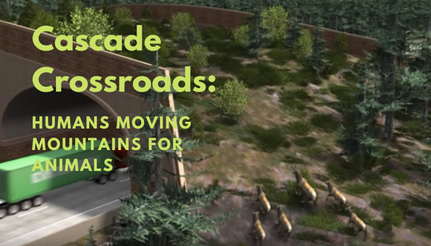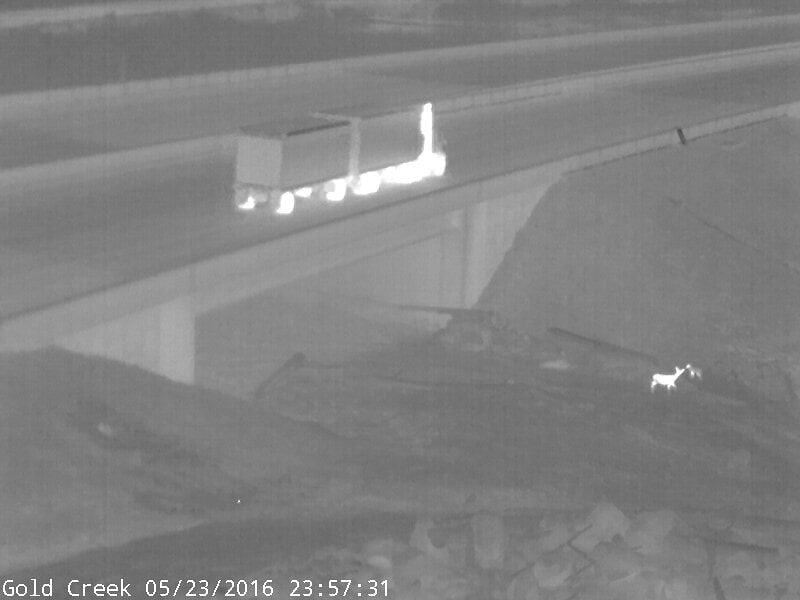
Anybody living in Washington state knows that the I-90 corridor is the great connector between the eastern and western part of the state. The Snoqualmie Pass further “ties” the state together, linking highways to mountains and waterways, enabling economic access to everything from agriculture and tourism to shipping and freight.
The I-90 freeway also slices through the Cascade Mountains and connected ecosystems relied upon by treasured wildlife such as elk, wolverine, bear, deer, fox, and myriad species with habitat requirements—much like our own human need to move around our own neighborhoods and get to the grocery store and go about our daily lives.
Yet the animals are getting cut off by the I-90 corridor. They’re deterred by the traffic and the noise, for one thing, which affects their ability to roam in search of mates, food, and necessary territory for species survival. And of course, there are wildlife-vehicle collisions (WVCs) every year, causing damage and death to animals and humans.
Cascade Crossroads is a documentary telling of how the I-90 Wildlife Bridges Coalition was formed of people from different organizations and people of all persuasions, working together to develop a forward-thinking plan that included multiple wildlife overpasses and underpasses and whose work became a shining example of what can happen when business, community and government work collaboratively.
Something had to be done—but had to be done right
Spearheaded by an organization called Conservation Northwest and a collaborative effort that ultimately involved some 17,000 people and millions of dollars in funding, The Cascades Conservation Partnership helped secure 45,000 protected acres of National Forest Land for reconstruction of I-90. Out of this effort came the Wildlife Bridges Coalition, which included AAA Washington, Sierra Club, and many others.
Imagine the early days of this group, starting with representatives from road safety and wildlife protection as well as engineers at Washington State Department of Transportation (WSDOT). There was a great deal of mistrust from the start, a lack of acceptance of the environmental engineers, for one, because of their conventional way of doing things. They were challenged with: What would it take to do it differently? To design something with wildlife in mind?
Getting the message—and the animals—across

It took some time. The coalition went out and engaged the public, including young children, by creating the “Bridging Futures Coloring Project.” With kids involved in understanding the importance of connected habitat and wildlife bridges and underpasses, parents became educated and there was an evolution of thinking. Ultimately, when the coalition’s environmental impact statement was published, it received 1300 comments—all favorable and encouraging of ecological connectivity.

The group went on to study snow tracking of animals. They tracked how animals approached the highway, where they stopped, where they went around or tried to cross. Further studies were done in Banff, Canada, which has a total of 44 wildlife crossing structures and since 1996 has engaged in the continuous research and monitoring of these crossings. Based on all of its findings and research, the coalition provided analysis and development recommendations, and much to its surprise, the suggestions were well received and all ideas were opted for.
At the close of 2019 Snoqualmie Pass East project has seen some of the first wildlife overpasses built and already some wildlife “wins” as seen in the photos of the many elk, deer, and other animals readily using the structures.
The Snoqualmie Pass will ultimately include overcrossings and underpasses that are 156-feet wide, 60-feet tall, and span six lanes of traffic. They’ll be fully vegetated so that as wildlife move across they’ll never even know they’re over a highway! To encourage new plant growth, the Forest Service is planting thousands of native plants every year to provide food sources for wildlife and to encourage survival of species. All aspects of the project should be complete by 2029.
You can also find out more about the Cascade Crossroads documentary and how to use it to inspire action in your own community. Like this article? Share it with someone who loves wildlife! And we’d love your feedback and comments
